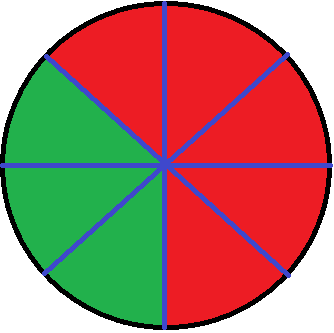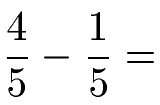We explain how to subtract fractions, including how to bring fractions to a common denominator, how to subtract them afterwards and what the shortening is all about. Examples are also used to show how this part of the fraction calculation works.
How to subtract fractions: Overview
First off all, let’s explain that the top half of a fraction is called the ‘numerator’ and the bottom half is called the ‘denominator’. In the case of fractions with the same denominator — a ‘common denominator’ — all fractions have the same denominator (the number below the fraction line). Sometimes, when the denominators do not appear to be common, we can still make them so … more on that later! Also read
how to calculate percentage error in chemistry, physics and business
For a simple explanation of how fractions work, let’s take a pizza and cut it into 8 pieces. The pieces are all the same size. The next graphic shows this:

The pizza consists of 8 pieces. From these 8 pieces we now eat 5 pieces (marked in red). Therefore 3 pieces remain (marked in green). The next graphic shows you this:

How can you express this with fractions? It’s actually quite simple: at the beginning we have 8 of 8 pieces and we eat 5 of 8 pieces. This leaves 3 out of 8 pieces. This is written out like this:

As you can see: Here a subtraction is simply carried out on the numerators. The denominator remains the same — it is thus a ‘common denominator’.
Note:
In fractions, a distinction is made between fractions of the same denominator — the common denominator — and fractions with a different denominator. Also read how to find area of square, rectangle, triangle, circle, cylinder, trapezoid, prism, sphere, parallelogram, cone, polygon
Examples of subtracting fractions
In this example, let’s look at the subtraction of fractions on for like, unlike, and mixed fractions . Let’s start with fractions of the same name, i.e. subtraction tasks with a common denominator.
Example 2 :
What is the solution to the next task?

Solution:
We have two fractions of the same denominator (common denominator) here, because the denominator is 5. So we can simply subtract in the numerator. The denominator simply remains the same in the result.

Example 3 :
What is the solution to the next task?

Solution:
Here, too, we have fractions with a common denominator. Therefore, we can simply leave the denominators as they are and do the subtractions in the numerator. 10 – 3 – 1 = 6. We get 6/9 as the result. This could be shortened … more on that below!

How to subtract fractions with different denominators
The first three examples were for fractions with a common denominator. The next examples relate to fractions without a common denominator.
Example 4 :
What is the solution to the next task?

Solution:
The denominators are different. We must therefore not simply subtract here, but must first find a common denominator. The easiest method to understand is to be shown through the steps to do this. Also read how to find interquartile range (IQR) easily: step-by-step guide
The first step is to find a common denominator. To do this, we multiply the two denominators together: 5 · 4 = 20. The common denominator is 20. For a better understanding, we write this briefly:

We still lack the numerators. The first fraction had a 5 in the denominator. We have to multiply that 5 by 4 to get the 20. So we multiply the numerator by 4. We get 3 · 4 = 12. The second fraction had a 4 in the denominator. To get here to 20, you had to multiply by 5. We also do this in the numerator: 2 · 5 = 10.

Now we can just subtract the numerators. The denominator stays the same.

Note: This fraction can still be shortened. We’ll see how this works below.
Example 5 :
The next subtraction problem involves three fractions. How do you calculate this?

Solution:
We have three different denominators here. We are therefore looking for a common denominator. We use the least common multiple for this . To do this, we take the three denominators and multiply them by 1, 2, 3 and so on. Then we look for the smallest number that occurs in all of them. This is the 18…

To get to the 18 in the denominator, we have to multiply by 6 on the first fraction. For the second fraction we have to multiply by 2 and for the third fraction we do not have to do anything (multiplication by 1). This is exactly what we do here.

Now we can just subtract in the numerator. The denominator remains as always.

This fraction can still be shortened. We’ll see how this works below.
Subtract mixed fractions :
Let’s still take care of the subtraction of mixed numbers / mixed fractions. In order to be able to subtract these, we first convert them into normal fractions and then subtract them.
Example 6 :
What is the solution to the next task?

Solution:
Converting is very easy. We multiply the number before the fraction by the denominator in the numerator and treat the denominator at. Then we add the fraction.

The task then looks like this:

Unfortunately, we still have different denominators. So we need a common denominator. With 2 · 3 = 6 we get this. So we multiply the first fraction and the third fraction by 3 and the middle fraction by 2.

This fraction could also be shortened. We’ll see how to shorten in the next section.
Shortening the fraction
Fractions can be shortened in some cases. To abbreviate means to divide the numerator and denominator by the same number. Usually this is only done for natural numbers. You can use the divisibility rules to find out whether the number in the numerator and denominator is divisible by another (natural) number without a remainder . Whereby you can often see this at first glance with smaller numbers. Here are a few quick examples.
Example 7 :
Here are a few examples of shorteningfractions. The first fraction has been reduced by 2 (numerator and denominator can be divided by 2 without a remainder). The second fraction has been reduced by 3 (numerator and denominator can be divided by 3 without a remainder).

How to subtract mixed fractions in detail
Now let’s look at mixed fractions. So we have fractions where the numerator is definitely greater than the denominator. Some examples of how to subtract a mixed fraction — which is also a handy method for how to subtract fractions with whole numbers:

Suppose we are talking about a cake: In the first case we have “3 whole” and a half cake. In the second example we have five whole cakes and 2/3 of another cake and so on. In order to be able to calculate with the fractions, one should convert the mixed fraction. You keep the denominator and multiply the whole number in front by this denominator. You can then add the two fractions. Some examples:

You can then add, subtract, multiply and divide these numbers as usual. If, on the other hand, you want to generate mixed numbers, you have to go the opposite way. The best way to do it is as follows: You calculate numerator by denominator and see how many whole things have been created. The rest is then represented as a fraction. Example: 7: 2 = 3.5. So we have 3 wholes and there is 1: 2 left. For all examples:

Summary, quick guide and FAQ
If you’re supposed to subtract two fractions with the same denominator (number below the fraction line), subtract the numerator (number above the fraction line) and keep the denominator. Also read how to find a correlation coefficient.
If you are supposed to subtract two fractions with different (unlike) denominators, then you must first expand the fractions so that you have two fractions with the same denominators (a common denominator). Then you can subtract the numerators and keep the denominator.
How can I calculate the common denominator?
The easiest way to find the common denominator is to multiply the denominators of the fractions. In example 2 that would be invoice
What number do I have to expand with?
If you divide the main denominator by the denominator of the fraction, the result is the number that you need to expand with. In the example it would be 12/3 = 4 for the first fraction and 12/4 = 3 for the second fraction.
What should I do if I have to subtract two fractions from each other?
The subtraction of the fractions works just like the addition. If the denominators are the same, subtract the numerators and keep the denominator. If the denominators are different you have to look for the main denominator, expand the fractions and then subtract the numerators from each other and keep the main denominator.
So, put simply in other words, a second fraction is “deducted” from one fraction (mathematicians call this subtraction). First, a small overview of the 3 steps that need to be done in most cases to subtract fractions:
- Bring fractions to a common denominator
- Subtract fractions
- Shorten the resulting fraction
These are the three steps that, when used correctly, will produce results. We will now address each of these points individually and explain what is behind them.
Step 1: bring fractions to a common denominator
To be able to subtract fractions, both must have the same denominator. As a reminder: The denominator was what is “below” in the fraction. And that must – as already indicated – be the same for both. The important thing is that the value of the fraction must not change. The following knowledge helps: 1 out of 2 equal pieces of a cake is the same as 2 out of 4 equal pieces of a cake.
- The two denominators are multiplied together. Since 2 x 4 is known to be 8, the denominator for the new fractions is 8.
- The numerator of the first fraction is multiplied by the denominator of the second fraction. This gives 3 x 2 = 6. This 6 is the new numerator of the first fraction.
- The numerator of the second fraction is multiplied by the denominator of the first fraction. 1 x 4 = 4. This 4 is the new numerator of the second fraction.
Step 2: subtract the fraction
Once you’ve got the fraction down to a denominator, subtracting the fractions is easy.
- The two numerators are subtracted and give the result.
- The denominators are the same.
So it’s very simple: just subtract the numerators and that’s it. The denominator remains the same. Note: If the second fraction is larger than the first, a negative result is produced, as with the subtraction. Example: 1/4 – 3/4 = -2/4.
Step 3: shortening fractions
Even after a subtraction, it may be necessary to shorten the fraction. This works the same way as in Adding Fractions.
If you did step 1 and step 2 of substracting fractions correctly, you should have calculated the correct result. However, there is often the option to simplify this even further. The smaller the numbers, the easier it is. That is why the fractions are shortened. This works when the numerator and denominator are divisible by the same number without a remainder.
When shortening very large numbers, it is often clever to cut several times. Say the numerator and denominator first shorten with e.g. 2 or 3. And when you see “The fraction can also be shortened” then shorten it further.




